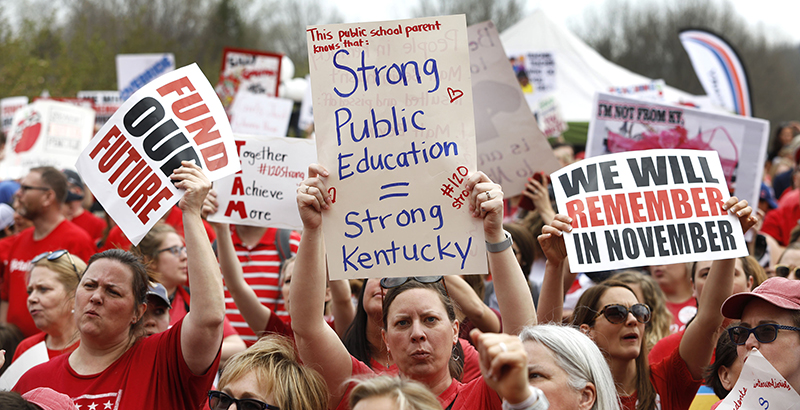Union Report: How Much Control Do Unions Have Over Teacher Protests? In Some States, a Lot. In Others, None at All

Mike Antonucci’s Union Report appears Wednesdays; see the full archive.
“Oil companies don’t have rallies. Insurance companies don’t have rallies. Betsy DeVos doesn’t have rallies. They don’t have to. Money is their influence. Our voice is our power,” tweeted Lily Eskelsen García, president of the National Education Association, after attending a teacher rally in Austin, Texas, on March 11.
Teacher unions do love rallies. The difference in the current spate of protests is that “our voice” may be coming from somewhere other than union headquarters.
To be sure, the formal union structure still organizes and funds the majority of actions across the country. The Austin protest was a joint venture of the Texas State Teachers Association and the Texas American Federation of Teachers. Neither union, it needs to be said, is the largest teacher organization in the state.
The Indiana State Teachers Association organized a rally at the state capitol March 9. The Maryland State Education Association held its protest March 11, and it is worth delving into just how much went into that effort.
The March for Our Schools had been in the planning stages since late last year. The union hired an organizer specifically to work on the event, and in January the union’s board of directors approved spending $470,000 on the rally. The directors were told, “the goal is to have 10-15,000 attendees.” The rally was well attended, with estimates ranging from 7,000 to 8,500 protesters, but apparently it fell far short of the stated goal.
Still, the rally must be considered a success: The protesters chanted “Fund Our Schools!” and the press delivered their message. I couldn’t find a media report that mentioned Maryland’s current school funding, so I checked.
In fiscal 2018, the state spent $15,467 per pupil. Maryland’s lowest-spending district, Talbot County, spent $13,414 per pupil. That’s higher than the average in 35 states.
NEA ranks Maryland seventh in the nation in average teacher salary and 13th in overall school spending.
More statehouse rallies are on the way. The Massachusetts Teachers Association budgeted $600,000 for its Fund Our Future campaign that will culminate with a May 16 protest. The California Teachers Association approved a “day of action” in Sacramento, likely May 1.
Elsewhere, though, the unions are less in control of events. Last year’s West Virginia teacher walkout continued even after union leaders concluded a preliminary deal with the legislature. The Arizona walkout was headed by an ad hoc group.
In Kentucky, there are multiple players in teacher activism. The past two weeks have seen four teacher sickouts in the Jefferson County Public Schools, none of which were called by the local or state teachers union.
The first was organized by KY 120 United, a grassroots group similar to the one is Arizona. But when KY 120 United called on teachers to return to work, a so-called splinter group dubbed JCPS Leads continued the sickouts.
The confusion reached its pinnacle March 12. Jefferson County Superintendent Marty Pollio and Jefferson County Teachers Association Brent McKim reached a deal that would keep the schools open. The district would grant an additional 2,000 hours of union release time to allow three teachers per school to rally at the capitol.
The state union and KY 120 United specifically requested Jefferson County teachers to report to work March 12 because students were scheduled to take the ACT college admissions test.
As it turned out, Pollio apparently negotiated with the wrong teacher leader, because one-third of Jefferson County teachers called in sick, and schools were shut down. The ACT was rescheduled for April 24.
Kentucky Gov. Matt Bevin put blame on the union, which was obviously misplaced, but if the union doesn’t represent teachers, why have it?
Kentucky may be an outlier, but now Tennessee is walking a similar path. Three members of the Tennessee Education Association formed TN Teachers United, claiming TEA is not fighting hard enough for teachers.
“They’re not listening to the members, and the members are ready for action,” said Tikeila Rucker, president of the United Education Association of Shelby County.
There is some irony in Rucker leading this effort, since she largely owes her position to TEA. In 2015, the Memphis-Shelby County Education Association seceded from the state union and NEA. The state and national unions immediately created a new local in the area and installed Rucker as president.
The new group is receiving the assistance of Chris Brooks, an organizer from Labor Notes, a pro-union media organization. The group says it doesn’t want teacher strikes, but Brooks’s reaction to the fact that teacher strikes are illegal in Tennessee was telling.
“They aren’t God’s laws,” he told the Commercial Appeal. “They can be broken. Districts don’t have the resources they need, teachers don’t have the resources they need. Teachers are leaving in droves. The idea that if thousands go on strike, districts will fire them is laughable.”
Legislators and school district administrators are going to have to demonstrate the ability to be nimble. Large-scale rallies organized by established unions require one approach; guerrilla actions organized by splinter groups require another.
Splinter groups also require unions to be nimble. Are they supplementing or undermining the union’s authority?
We haven’t seen much evidence so far that any of the players are up to the task. That’s more of a concern than how many rallies or walkouts we face in the coming months.
Get stories like these delivered straight to your inbox. Sign up for The 74 Newsletter

;)